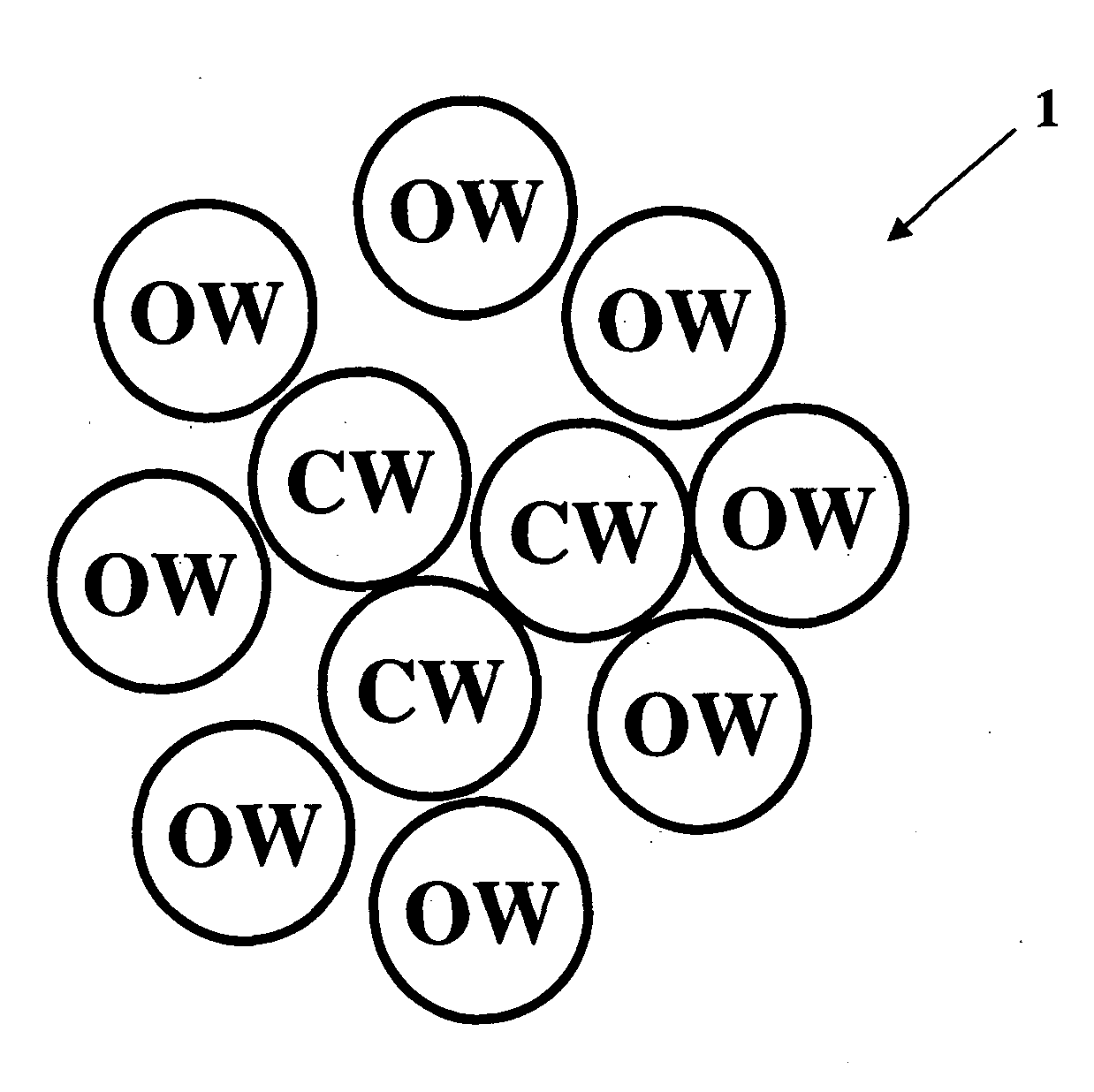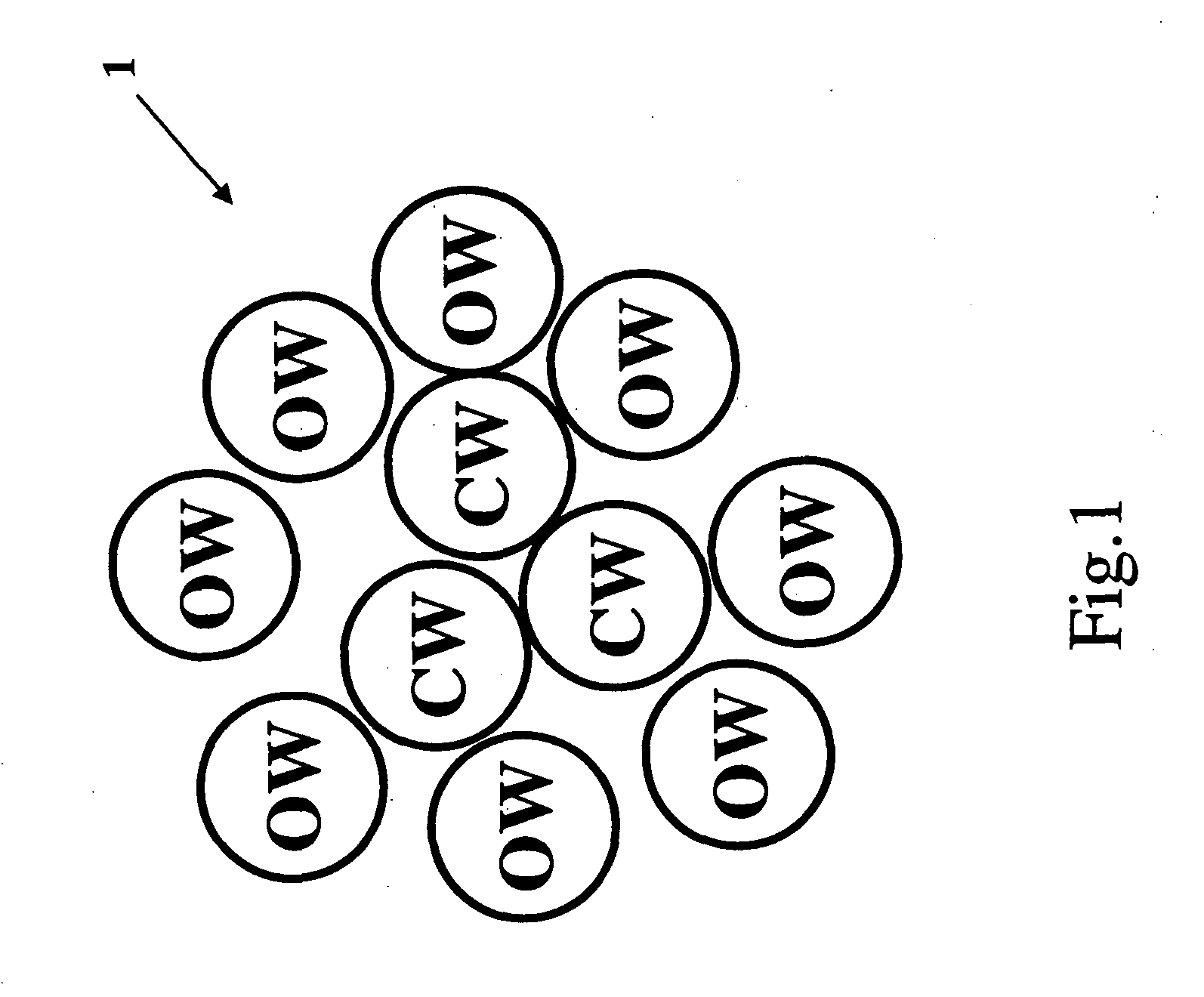Metallic cord comprising preformed and non-preformed wires, rubber sheet comprising said cord and tyre comprising at least one layer derived from said rubber sheet
a technology of preformed wires and non-preformed wires, which is applied in the field of metalic cords, can solve the problems of increasing manufacturing costs, reducing productivity, and unstable two-dimensional waved filaments, and achieves good penetration of rubber, and good sealing effect of rubber
- Summary
- Abstract
- Description
- Claims
- Application Information
AI Technical Summary
Benefits of technology
Problems solved by technology
Method used
Image
Examples
example 1
[0058]An exemplary “11×1” cord according to the invention, as that shown in FIG. 1, was prepared, having the features reported in Table 1. All the outer wires were sinusoidally preformed with a waveform having a peak-to-peak height of about 0.4 mm and a wavelength of about 2 mm, whereas the three core wires were non-preformed wires.
TABLE 1Core Wire (CW) diameter0.33 mmOuter Wire (OW) diameter0.33 mmTwist directionSTwist pitch 20 mmSteelNTWire CoatingBrass
[0059]A comparison cord, having a “3+6” structure formed by non-preformed wires with the features of Table 2 was also prepared.
TABLE 2Core Wire (CW) diameter0.35 mmOuter Wire (OW) diameter0.35 mmTwist directionSTwist pitch 18 mmSteelHTWire CoatingBrass
[0060]Table 3 reports the results of some tests performed on the two cords. In particular, the tensile features and the rubber penetration capability of the cords were evaluated. In particular, the rubber penetration capability was evaluated on a green sheet portion comprising a numb...
example 2
[0063]Four exemplary cords were prepared, having eleven wires disposed in a “11×1” structure. In all the tests, the wires had a diameter of 0.33 mm and the twist pitch of the cords was set to 20 mm. The wires were brass coated SHT steel wires.
1) A first cord (comparison) was a cord formed by eleven non-preformed wires.
2) A second cord (comparison) was a cord formed by eleven preformed wires.
3) A third cord (invention) was a cord formed by three non-preformed core wires surrounded by eight preformed wires (peak to peak height 0.40 mm, wavelength 2 mm).
4) A fourth cord (invention) was a cord formed by three non-preformed core wires surrounded by a crown of eight wires, comprising non-preformed wires alternated to preformed wires.
[0064]Table 4 reports the properties and the rubber penetration capability (entrapped air) of the four cords 1) to 4). The rubber penetration capability values are reported taking as a reference value “100” the rubber penetration of the cord 1) formed by non-p...
example 3
[0066]Three rubberized sheets were prepared comprising a plurality of different types of parallel cords.
1) thickness 2.40 mm, cord “3+9+15” formed by non-preformed wires having a diameter 0.22 mm, cord density 45 cords / dm, NT steel (comparison).
2) thickness 2.10 mm, cord “3+6” formed by non-preformed wires having a diameter of 0.35 mm, cord density 48 cords / dm, HT steel (comparison).
3) thickness 2.20 mm, cord “3+8” formed by three non-preformed core wires surrounded by eight preformed outer wires having a diameter of 0.33 mm, cord density 48 cords / dm, NT steel (invention).
[0067]Table 5 shows some properties of the three rubberized sheets.
TABLE 53 + 9 + 15 × 0.22*3 + 6 × 0.35*3 + 8 × 0.33Average cord1.641.371.36diameter (mm)Centre-to-centre2.222.082.08distance (mm)Width of only0.580.710.72rubber portionsbetween cords(mm)% steel (average746665diam × corddensity)Sheet breaking128000118000127000strength (N)Sheet stiffness477370(TEX)(*comparison)
[0068]The above results show that the cord...
PUM
| Property | Measurement | Unit |
|---|---|---|
| diameter | aaaaa | aaaaa |
| diameter | aaaaa | aaaaa |
| diameter | aaaaa | aaaaa |
Abstract
Description
Claims
Application Information
 Login to View More
Login to View More - R&D
- Intellectual Property
- Life Sciences
- Materials
- Tech Scout
- Unparalleled Data Quality
- Higher Quality Content
- 60% Fewer Hallucinations
Browse by: Latest US Patents, China's latest patents, Technical Efficacy Thesaurus, Application Domain, Technology Topic, Popular Technical Reports.
© 2025 PatSnap. All rights reserved.Legal|Privacy policy|Modern Slavery Act Transparency Statement|Sitemap|About US| Contact US: help@patsnap.com



